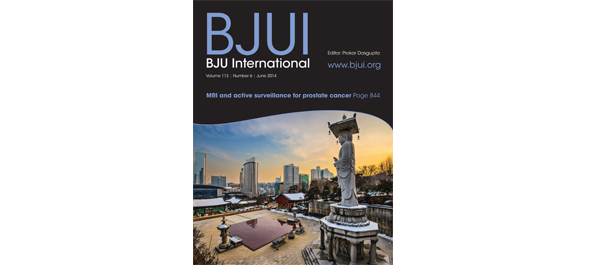
Editorial: Mirabegron the first β3-adrenoceptor agonist for OAB: a summary of the phase III studies
The study reported in this edition of BJUI details the results of a large phase III study conducted in Japan contrasting 50 mg mirabegron, the new β3-adrenoceptor agonist, to placebo with tolterodine as an active comparator [1]. This adds to the body of knowledge already provided by phase III evaluations reported from Europe [2], where tolterodine was also used as an active comparator and North America [3], where the efficacy of 25–100 mg was compared with placebo [4]. As the first in…

5 Questions with Per-Anders Abrahamsson and Gopal Badlani
Secretary Generals to the big Spring Meetings, European Association of Urology and the American Urological Association
Every Spring, thousands of urologists gather in big cities with mega-venues to attend one or both of the annual congresses of the EAU and the AUA. These are big events with respect to release of the latest scientific trials, instructional courses, plenary sessions, and of course multiple ways to see and interact with advances in industry partners. But who orchestrates these massive…

Editorial: Squamous cell carcinoma of the penis: therapeutic targeting of the EGFR
Squamous cell carcinoma of the penis is a rare genitourinary malignancy. There are wide variations in its incidence, ranging from 0.1 to 0.9/100 000 men in Europe, where it accounts for 1% of male malignancies, to as high as 4.4 and 4.2/100 000 men in Uganda and Paraguay, where it accounts for up to 10% of male malignancies.
The management of patients with advanced squamous cell carcinoma of the penis, including those patients with node-positive disease and metastatic disease,…

A new take on GPS navigation? Summary of the June #urojc twitter debate.
The diagnosis and management of prostate cancer continues to rapidly evolve, with heavy debates at each stage of the evolution process. The key trade off between avoiding the over diagnosis and overtreatment of low risk indolent tumours, versus failing to diagnose and act on what may progress to aggressive disease, is an on going theme in the debate.
Research into various diagnostic tools to help both the patient and clinician stratify individual risk is on going, however the heavy consequence…

Editorial: Early stent removal after pyeloplasty
In the current issue of BJUI Danuser et al. [1] present their prospective randomised single-centre study evaluating the effectiveness of 1-week vs the more traditional 4-week ureteric stent placement, after either a laparoscopic (LPP) or robot-assisted laparoscopic pyeloplasty procedure (RALPP) for PUJO.
In recent years LPP and RALPP have become the standard treatments for PUJO. In the adult population most patients undergoing this procedure require a period of ureteric stenting…

The Big Data challenge: amplify your content using video and maximise your impact
3 Comments
/
It remains a great achievement for an author to have his or her work published in a peer-reviewed journal such as the BJUI. There is a tremendous sense of fulfilment when the e-mail from the Editor-in-Chief includes ‘accept’ in the subject heading. What may have been a long period from study design, through ethics approval, patient recruitment, intervention, data collection, statistical analysis, manuscript preparation, to final revisions, finally comes to an end – chapter closed, move on.
However,…

Editorial: Multiparametric MRI and active surveillance for prostate cancer: future directions
A growing body of data exists suggesting an important role of MRI in selecting men with prostate cancer for active surveillance (AS). In the present study, Park et al. [1] show that a suspicious lesion on MRI was independently predictive of adverse pathology after radical prostatectomy (RP). This finding supports existing data suggesting that suspicious lesions on MRI confer an increased risk of disease reclassification among men enrolled in AS [2]. Indeed, in our institutional AS experience we found…

The value of fresh cadaveric dissection
I am very lucky to have had the opportunity recently to undertake research in the fresh cadaver lab at University of Maryland School of Medicine, Baltimore.
The availability and quality of fresh cadaveric specimens at the School of Medicine was outstanding. The School’s Anatomical Services Division is also the site of the Maryland State Anatomy Board, and processes over 2000 cadavers per year. No after death donations by family members are accepted. By word of mouth, public awareness of the…

Editorial: Enhanced recovery programmes: an important step towards going lean in healthcare
Enhanced recovery programmes (also known as clinical care pathways) are excellent examples of ‘lean thinking’. The ‘lean’ approach is derived from the management philosophy known as the ‘Toyota Production System’ (TPS) that helped the Japanese company become the world's largest automaker. This management approach has been widely adopted throughout the manufacturing world and has revolutionised the way many businesses operate. Indeed, the concept of clinical care pathways has its…

AUA 2014 – Monday, Tuesday, Wednesday: “The Tweeter’s Congress”
Thanks to @rmehrazin and @uroncdoc for a great summary of the first three days of #AUA14. This year’s meeting has been a phenomenal success, especially with regards to Twitter use during the Congress and the dissemination of content surrounding the meeting. You know how it goes – ‘sorry I can’t catch your session because I have to be somewhere else’. Well not anymore. Keep the #AUA14 search feed on your Twitter app, and the stream of information on posters/podiums or plenary was tremendous!…
